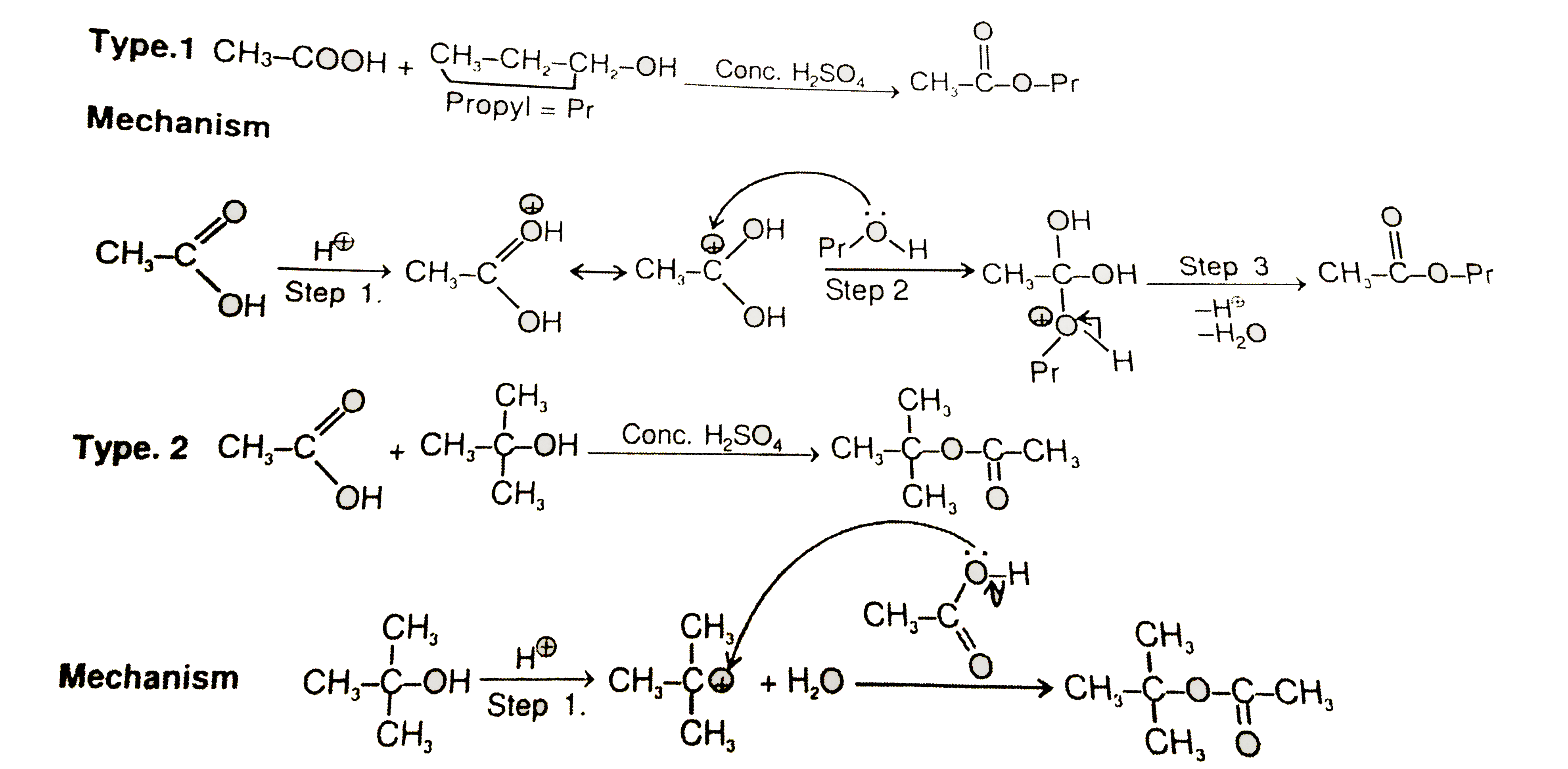CH3CH2OHConc.H2SO4−−−−−−−−−−→443KX+H2O
Complete the above reaction and explain the mechanism.
To complete the reaction and explain the mechanism, we start with ethanol (CH₃CH₂OH) reacting with concentrated sulfuric acid (H₂SO₄) at a temperature of 443 K. The reaction leads to the formation of an alkene (denoted as X) and water.
1. Identify the Reactants:
- The reactant is ethanol (CH₃CH₂OH) and the reagent is concentrated sulfuric acid (H₂SO₄).
2. Understand the Reaction Type:
- The reaction is a dehydration reaction, where water is removed from the alcohol to form an alkene. The temperature (443 K) is crucial as it favors the formation of alkenes.
3. Protonation of the Alcohol:
- The oxygen atom in ethanol has lone pairs and can act as a base. It will extract a proton (H⁺) from sulfuric acid, leading to the formation of an oxonium ion:
CH₃CH₂OH+H₂SO₄→CH₃CH₂OH₂++HSO₄−
4. Formation of a Carbocation:
- The protonated alcohol (oxonium ion) undergoes loss of water (H₂O), resulting in the formation of a carbocation:
CH₃CH₂OH₂+→CH₃CH₂++H₂O
5. Deprotonation to Form Alkene:
- The carbocation (CH₃CH₂⁺) can lose a proton (H⁺) to form the alkene. In this case, the most stable alkene formed is ethene (X):
CH₃CH₂+→CH₂=CH₂+H+
6. Final Product:
- The final product (X) is ethene (C₂H₄), and water is released as a byproduct:
CH₃CH₂OHH₂SO₄,443K−−−−−−−−→C₂H₄+H₂O
Conclusion:
The value of X in the reaction is ethene (C₂H₄).
- The reactant is ethanol (CH₃CH₂OH) and the reagent is concentrated sulfuric acid (H₂SO₄).
- The reaction is a dehydration reaction, where water is removed from the alcohol to form an alkene. The temperature (443 K) is crucial as it favors the formation of alkenes.
- The oxygen atom in ethanol has lone pairs and can act as a base. It will extract a proton (H⁺) from sulfuric acid, leading to the formation of an oxonium ion:
CH₃CH₂OH+H₂SO₄→CH₃CH₂OH₂++HSO₄−
- The protonated alcohol (oxonium ion) undergoes loss of water (H₂O), resulting in the formation of a carbocation:
CH₃CH₂OH₂+→CH₃CH₂++H₂O
- The carbocation (CH₃CH₂⁺) can lose a proton (H⁺) to form the alkene. In this case, the most stable alkene formed is ethene (X):
CH₃CH₂+→CH₂=CH₂+H+
- The final product (X) is ethene (C₂H₄), and water is released as a byproduct:
CH₃CH₂OHH₂SO₄,443K−−−−−−−−→C₂H₄+H₂O
The value of X in the reaction is ethene (C₂H₄).
Topper's Solved these Questions
- BOOK - XII BOARD PREVIOUS YEAR PAPER ENGLISHCHAPTER - XII BOARDSEXERCISE - SET-II32videos
XII BOARDS
- BOOK - XII BOARD PREVIOUS YEAR PAPER ENGLISHCHAPTER - XII BOARDSEXERCISE - SET-III31videos
XII BOARDS
- BOOK - XII BOARD PREVIOUS YEAR PAPER ENGLISHCHAPTER - SAMPLE PAPER 2019EXERCISE - SECTION: D1videos
SAMPLE PAPER 2019
Similar Questions
Write the mechanism of the following reaction :
2CH3CH2OHConc. H2So4−−−−−−−→413KCH3CH2−O−CH2−CH3View SolutionObserve the esterification mechanisms for primary and teriary alcohols.

CH3−COOH+C2H518OHConc.H2SO4−−−−−−−→(P)
CH3−COOH+(CH3)3C−18OHConc.H2SO4−−−−−−−→(Q)
In the above reaction (P) and (Q) are respectivelyView Solution
Knowledge Check
- Question 1 - Select One
CH3CH2CH2OHconc. H2SO4−−−−−−−−→170∘CACl2−−−→500∘CB.
A and B. areAA=CH3CH2CH3,B=CH3CH2CH2ClBA=CH3CH=CH2,B=CH2ClCH=CH2CA=CH2=CH2,B=CH3CH2ClDA=CH3CH2CH3,B=CH3CH=CH2 - Question 2 - Select One
CH3CH=CH2NaBD4−−−−−−→H2O2/OH Product X, X is :
ACH3C∣OHHCH2DBCH3C∣DHCH2OHCCH3C∣ODHCH3Dnone is correct
CH3CH2OHH2SO4(conc.)−−−−−−−−−→443K[A]H2O/H+−−−−−→[B]PCI5−−→[C]
View SolutionIdentify (Z) in the series.
C3H7OHconc.H2SO4−−−−−−−−−→443K(X)Br2−−→(Y)Excess of −−−−−−−−→alc. KOH(Z)View SolutionCH3−C≡CHLinddar's−−−−→catalyst(A)ConcH2SO4−−−−−−→H2O(B)
What are the products (A) and (B) in the given reaction?View SolutionCH2OCHD2MgI−−−−−−→H3O⊕XConc.H2SO4−−−−−−−→ΔY
In the above reaction compound X & Y respectively will beView SolutionBut-1-ene(CH3COO)2Hg−−−−−−−−−→H3O?
The product in the above reaction isView SolutionIdentify Z in the series
CH3CH2CH2OHconc.H2SO4−−−−−−−→160−180∘C(X)Br2−−→(Y)alc,KOH/Δ−−−−−−−−→NaNH2/Δ(Z)View Solution

